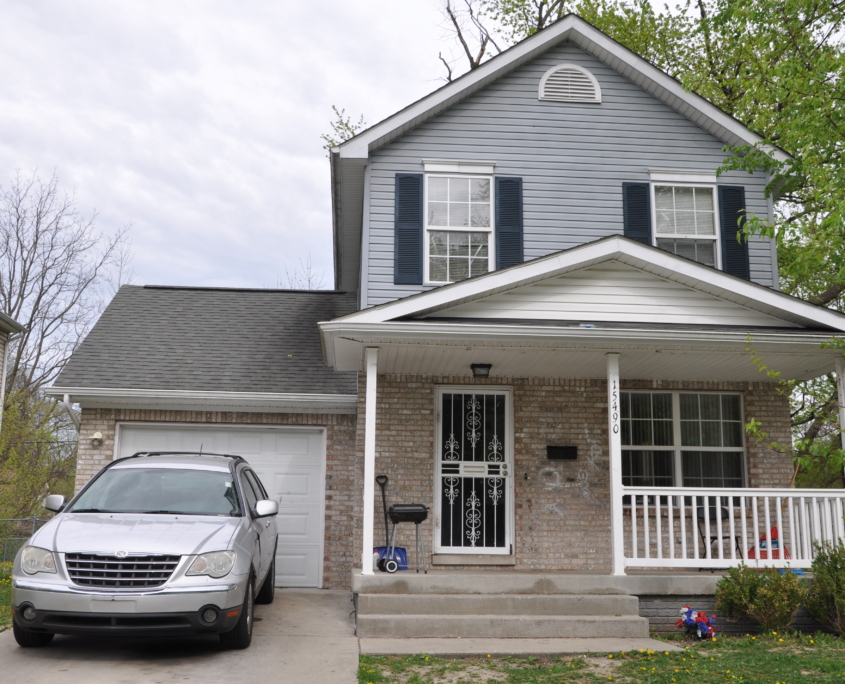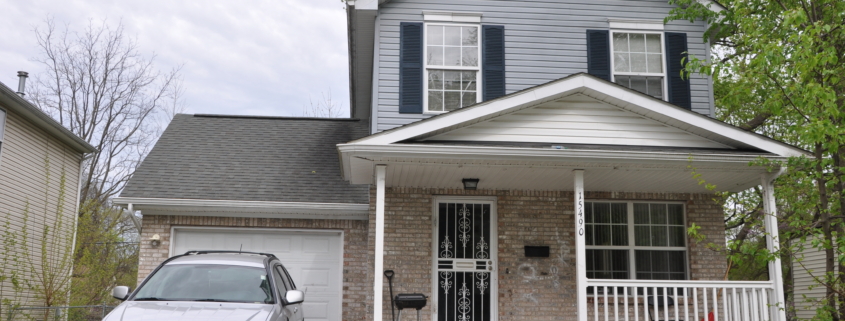This story of a carbon monoxide hero tells how one person rescued four people from carbon monoxide poisoning death.
By Rebecca Martin
“Heroes are ordinary people who make themselves extraordinary.” ― Gerard Way
Heroes are sometimes made in dire circumstances which require both a level head and bravery. They say the world knows little of its greatest heroes because ordinary people acting in extraordinary circumstances are often overlooked in the mainstream media. When an individual turns a tragedy into a triumph it is always noteworthy because lives are saved as a result. This is the story of one such carbon monoxide hero: Raushanah Hardison.

Raushanah Hardison became a carbon monoxide hero when she rescued four family members from this house in April of 2017. Even newer single family homes can have severe carbon monoxide poisoning events. Here a high efficiency furnace was producing 9,000 ppm CO in the exhaust because of poor maintenance by the HVAC company and the property management company.
The story begins in Michigan in April of 2017. Raushanah was living around the block from her cousin, Tammy, her two children; and their stepfather. In the early morning hours of April 17th, Raushanah received a phone call from Tia, Tammy’s sister, informing her that something was wrong at her sister’s house and could she please go and check on them. Tia had received a phone call from Tammy in which Tammy had only been able to utter the word ‘help’. A 911 call made a minute before was terminated because Tammy wasn’t able to tell the operator where she was.
Raushanah drove to her cousin Tammy’s house immediately and knocked loudly on the locked door. Eventually the door was opened by the stepfather, who had to crawl to answer the door as he was unable to stand. Raushanah did not see anyone in the immediate vicinity and immediately ran upstairs calling out loudly for her cousin, Tammy. She found Tammy in her room in what she described as a zombie-like state with yellow foam coming from her mouth.
As Tammy suffered from asthma, Raushanah immediately located Tammy’s inhaler but Tammy was unable to use it in her condition. Tammy’s sister, Tia, called at this time to get an update and proceeded to call 911, and first responders were immediately dispatched.
Carbon Monoxide Hero Rescued Children First
Raushanah then went to locate the two children. She found the daughter in her room, unable to stand. She had tried to stand and fallen. She located the son unresponsive in his room. Efforts to arouse him were not successful. By this time, Raushanah was beginning to feel lightheaded even though she had been in the home a matter of minutes. She estimated that it had been under 5 minutes at this time.
Raushanah immediately began removing her cousins from the house. Neither Tammy nor her two children were able to walk so Raushanah began dragging the children out the house, going down the stairs one at a time. First she got the daughter out of the house to the porch, then the unresponsive son. Tammy’s stepfather was closest to the door so he was able to make his way outside to the porch with assistance from Raushanah.
First responders arrived on the scene and Raushanah informed them that there was still one more person in the house, but that the smell in the house was too strong and she was unable to pull her out. The first responders were then able to remove Tammy from the house successfully. The entire family were transported to the hospital where nearly fatal levels of carbon monoxide exposure (carboxyhemoglobin) were documented in their blood. Raushanah herself did not seek treatment after her heroic efforts to rescue her cousins. In the following days she stopped to check that the house was secure. Her story of heroism that morning went unmentioned.
The Carbon Monoxide Hero is also at Risk
Raushanah has very few clear memories of the details following her brave rescue, whether it be conversations with family members who arrived shortly after or the first responders. She recalls an unfamiliar odor upon entering the home and nothing else unusual. When asked how she felt once everyone was out of the house she replied “relief”. Clarifying that her relief was for the family members who were safely outside but not for her own escape.
On this day in April of 2017, a line leader for a Ford distribution company accomplished an extraordinary feat that resulted in saving the lives of a family of four. Going above and beyond, she didn’t even mention her heroism on her social media, instead returning to her daily life with the humblest of attitudes, Her families well-being and work were her only rewards. She did not seek any damages from the incident though she complains of ongoing headaches. The world knows very little of our greatest heroes. Raushanah was truly a carbon monoxide rescue hero. For suing landlords in carbon monoxide cases, click here.
Defense Expert Not a Carbon Monoxide Hero
During the cross examination of the defense doctor Michael Holland, MD in 2019, he was asked why–though he had been provided with the deposition of Raushanah for review–he never referenced the information provided by Raushanah upon her arrival at the home.
Dr. Holland was not even aware of the correct sequence of events which is provided for you above. In fact he was unaware that Raushanah had been the first person to arrive and her role in removing the family from the house. When confronted about this omission to his findings, he cited brevity, though additional findings on his behalf showed little concern for brevity. In fact he had written some 70 pages without mentioning Raushanah’s initial discoveries as the first person on the scene.
In fact, Raushanah’s deposition goes on to discuss her perceptions of changes in her family members following the carbon monoxide exposure in detail. She describes a formerly close-knit family with frequent spontaneous get togethers which have turned socially distant in the aftermath.
The defendants hired Dr. Holland, from Saratoga, New York as an expert witness, to try to minimize the amount of damages awarded for this family. In his deposition, Dr. Holland tried to minimize his failure to rely on Raushanah’s observations of the four victims as not “unintentional oversight” on his behalf. His report ignored that at least one family member was totally unresponsive to external stimuli upon our carbon monoxide hero’s arrival. Dr. Holland further downplayed the levels of carbon monoxide in the home. Raushanah herself was impacted within a few minutes of entering the home indicating that carbon monoxide levels were incredibly high upon her arrival.
When questioned about the significance of complaints about amnesia, Dr. Holland claims that the length of amnesia is not an indicator for the severity of brain injury. He goes on to state that the length of coma determines the severity of deficits from carbon monoxide poisoning. There is little question in the medical literature that the recollection of a progressive timeline without gaps is important in determining the degree of brain damage.
Coma Levels Inform Severity in the Severe Poisoning Case
The defense doctor admits an unfamiliarity with the Rancho Los Amigos scale in which classifies the level of coma. As I once had a close family member suffer a severe traumatic brain injury, I know I found it surprising that about half of the levels used to evaluate comas involve the individual being able to ambulate, verbalize appropriately and follow directions. In fact the last level indicates an individual who is fully able to function independently with compensatory strategies and certain deficits which are permanent. The occurrence of depression is also a component of the tenth level of coma. In fact, only the first few levels of coma involve a patient who is bedridden in our societal view of coma and only the first level deals with a totally unresponsive patient.
Survivors of severe brain injuries can be described as “fine in the first 15 minutes”. A lucid interval, where an injured person can have a perfectly normal conversation with before slipping into a coma happens in a near majority of brain surgery cases. In other words, what we see in the span of an ER exam may not reveal actual deficiencies and without appropriate follow up, it would be very unwise to base our observations on those facts and those facts alone.
What must be presumed is that the discovery of a family unable to function without assistance and/or unresponsive, gives rise to concerns over what damage may have been done. And this is clearly laid out in Raushanah’s deposition. Dr. Holland had no idea how to reconcile the mission the defense attorney gave him, with the facts of brain dysfunction. While he should routinely be familiar with head injury as an ER doctor, he fumbled concepts of GCS and other coma scores. Ultimately, he had little choice to admit the severity of this injury, despite the ramblings of his 70 page report.
550 PPM is Lethal
The fire department had done readings at the home upon arrival but by then windows and doors had been opened and their readings showed 550 ppm. Dangerous levels by any account even if there had been some dispersal. When asked if 550 ppm was a dangerous level, the doctor replied ”it could be” even though any level above 101 ppm is considered dangerous. And according to United States Consumer Product Safety Commission. “At sustained CO concentrations above 150 to 200 ppm, disorientation, unconsciousness, and death are possible.” Dr. Holland eventually admits that a finding of 550 ppm after doors and windows had been opened “could be” considered a dangerous level of exposure. There is no “could be” about it. 550 ppm is lethal.
Ultimately, Raushanah’s heroism is something the defense and their expert witness could not run from. Raushanah Hardison, on April 17th, 2017, physically dragged two children from a home with dangerous and potentially lethal levels of carbon monoxide. She assisted the stepfather with exiting the home even though he was in proximity to the from door. And because she was experiencing a level of lightheadedness after only a few moments, she was unable to pull her cousin, Tammy from the home and had to defer to first responders.
Raushanah did not feel relief for herself after the fact, only relief for the safety of her family members. She did not seek answers and explanations from first responders, barely recalling conversations she had with them during the incident. She did not seek recognition for her act of heroism in any way. In recounting the time after the incident, she did not elaborate on the drama inherent in the scene but only expressed sadness at the changes in her family members in what she described as a once close knit family who genuinely enjoyed each other’s company prior to the incident in 2017. Her recounting of the events of that morning are matter of fact and focused on the safety of her family and little else.
Raushanah didn’t see herself as being an ordinary person doing something extraordinary or heroic. She saw herself as an ordinary person doing what an ordinary person would do to protect family with little thought to her own safety. The world, indeed, knows little of its greatest heroes.




Leave a Reply
Want to join the discussion?Feel free to contribute!